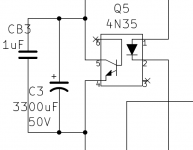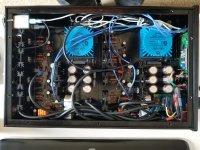The M2x uses the same optoisolator for the same purpose. This fragment of its schematic may be helpful.
The little "X" on two of the pins is KiCad Schematic Editor's symbol for "NOT CONNECTED" -- they tell the software that pins 3 and 6 of the 4N35 device are not connected to any other pins on any other components. This is true for the M2x and also true for the Whammy.
_
The little "X" on two of the pins is KiCad Schematic Editor's symbol for "NOT CONNECTED" -- they tell the software that pins 3 and 6 of the 4N35 device are not connected to any other pins on any other components. This is true for the M2x and also true for the Whammy.
_
Attachments
Over Pin1 to Pin2 - the current adjusts the brightness of the LED inside the 4N35 and the brightness of the LED adjusts the BJT inside the 4N35 (from Pin5 to Pin4). This is how I understood it.
Greets
Dirk
Greets
Dirk
In some applications pin 6 (base) is connection to ground via a resistor and some times a small cap is added also.
I think reason could be EMC when optocoupler is used in switching applications to prevent a false trigger.
I think reason could be EMC when optocoupler is used in switching applications to prevent a false trigger.
Hello Mr. Nut,
Pin6 of the 4N35 is not connected - if I remember right.
Cheers
Dirk
Thank you. That's the way it looked on the schematic, but I thought maybe I had misunderstood or something. Thanks for the clarification!
In some applications pin 6 (base) is connection to ground via a resistor and some times a small cap is added also.
I think reason could be EMC when optocoupler is used in switching applications to prevent a false trigger.
If I were to be experimenting with breadboarding that circuit should I connect pin 6 to ground via one of those methods or leave it floating? Will it harm anything to leave it floating? Which way would give the best performance?
Thank you!
The M2x uses the same optoisolator for the same purpose. This fragment of its schematic may be helpful.
The little "X" on two of the pins is KiCad Schematic Editor's symbol for "NOT CONNECTED" -- they tell the software that pins 3 and 6 of the 4N35 device are not connected to any other pins on any other components. This is true for the M2x and also true for the Whammy.
_
Thank you for the explanation!
If the purpose is for "auto bias" like in Whammy I would leave it floating. You could consider cutting the pin of totally 🙂 .....then less chance it will pickup some noise 🙂If I were to be experimenting with breadboarding that circuit should I connect pin 6 to ground via one of those methods or leave it floating? Will it harm anything to leave it floating? Which way would give the best performance?
Thank you!
If the optocoupler was the delay timer switch for a bomb I would consider grounding it via a resistor and small cap as you probably dont want a false trigger during power on.......
I just built a Whammy. The other channel have got a signifigant crossover distortion ( the other just a small, but existing). I have not yet had time to investigate more thoroughly, but have you had similar issues?
Maybe a good idea to measure the bias of output transistors?
Voltage drop over the source resistors will give you the current if you know the value of the source resistors?
Voltage drop over the source resistors will give you the current if you know the value of the source resistors?
Yep, did that. The bias current is almost 20 mA higher than on the other channel, for some reason. However similar within the channel, of both transistors, I mean. Rather strange... Have to keep on investigating.Maybe a good idea to measure the bias of output transistors?
Voltage drop over the source resistors will give you the current if you know the value of the source resistors?
So it is all buttoned up now.
Final conclusion, I love it.
listening through Beyerdymanics DT770 Pro 80ohms.
I built it balanced for two reasons:
1. To fit into the Main Stereo which is fully balanced from the Modified OPPO CD >> BAT Preamp >> Whammy
2. For the sheer fun of it.
Otherwise built stock per 6L6's instructions.
The LM833 sounds wonderfully balanced.
Some of the issues I had:
1. Plugged straight into Modded Oppo BDP105 with Sen IV mod
Sounded distorted and noisy
Hum present rising with the volume and not really acceptable
2. Plugged into Tape Out of BAT vk50se
Sounded better than above, still slightly distorted and noisy, but not as bad as 1
Hum present but lower and changes with volume knob too
3. Pluged into PreamOut of BAT vk50se (Best Solution)
Max volume on Whammy and use the Volume knob on the BAT for adjustment.
No distortion and almost imperceptible hum at Whammy max volume.
Was able to achieve desired SPL in the headphones.
Sounds absolutely amazing and this is what made me understand what everyone is talking about.
4. In options 1 and 2 above, generally, the volume output of the Whammy is low. (Using a 10k pot)
I find I can max out the volume a lot of the time, and could use more.
Searching the thread to see if there are more suitable resistance values to correct this.
Any advice as to why is appreciated.
All in, it was worth it,
Proposed future mods, just cause it was so much fun
Upgrade opamps to the BursonV6 classics. (Based on reviews, this is probably, my preferred, but may do some comparisons)
Upgrade Input CAPS
Install the Khadas DAC, Muses Volume, and OLED display.
Thanks again fo
Added the upgraded Input Caps and V6 classics.
First impressions are of a smoother and fuller sound. Definitely, an improvement, looking forward to continued improvement with the burn-in.
All issues with noise/hum seem to be gone or imperceptible, by changing the input XLR cable. The sound is great with both balanced and unbalanced headphone cables and had a good output with the notoriously difficult-to-drive HIFIMAN He6Sev2.
Attachments
Do you use 10 ohm source resistors?Yep, did that. The bias current is almost 20 mA higher than on the other channel, for some reason. However similar within the channel, of both transistors, I mean. Rather strange... Have to keep on investigating.
Do you should measure around 0.6V for 60 mA bias?
Are both channels "out of spec"?
Alright, I’m going to ask some really noob questions as I build this kit, so forgive me. I’ve built some Bottlehead kits and an ACA for reference, and many speakers/crossovers. And, yes, I’ve read the entire thread over the last week. Talk/explain things to me like I have very limited knowledge outside of that. And like I’m 12.
Wiring/connections from plug to ground and AC into board, I need to provide/source?
Resistors in the kit for r20/21/37/38 are the green, red, gold, gold banded ones?
Does the snubber at c20 have polarity?
Wiring/connections from plug to ground and AC into board, I need to provide/source?
Resistors in the kit for r20/21/37/38 are the green, red, gold, gold banded ones?
Does the snubber at c20 have polarity?
Last edited:
Very cool. What caps did you upgrade to? I'm thinking of throwing my M Supreme's 3.3uF in my WhammyAdded the upgraded Input Caps and V6 classics.
Noob question: does NO input cap provide better audio than even a high grade cap?
I have 0 DC offset on my input (I think that's what the caps are they for, yes?), so I've assumed it's best to have no caps.
(Still, those M Supremes are so pretty, I feel like I should use them. 🙂 )
I have 0 DC offset on my input (I think that's what the caps are they for, yes?), so I've assumed it's best to have no caps.
(Still, those M Supremes are so pretty, I feel like I should use them. 🙂 )
Correct. If you know your source will always have near 0mV DC, no cap is best. So long as you can keep the DC offset to the headphones below 20mV you're fine. But a high end head amp should be at a few mV or lower tbh.Noob question: does NO input cap provide better audio than even a high grade cap?
I have 0 DC offset on my input (I think that's what the caps are they for, yes?), so I've assumed it's best to have no caps.
(Still, those M Supremes are so pretty, I feel like I should use them. 🙂 )
I kind of like the peace of mind of having a cap. Especially since I like to run very expensive cans through mine
You are right, Ahess.
Reports on the input caps are mixed.
Some say they are better without and some say they can't hear the difference.
I am going with peace of mind as this is going to operate as a backup preamp as well as an HP amp. In a few years when my memory goes😉, I may use this in a totally different configuration and do not want to have to worry about it.
As for the sound, so far so good.
Reports on the input caps are mixed.
Some say they are better without and some say they can't hear the difference.
I am going with peace of mind as this is going to operate as a backup preamp as well as an HP amp. In a few years when my memory goes😉, I may use this in a totally different configuration and do not want to have to worry about it.
As for the sound, so far so good.
The caps are Mundorf MCap EVO Silver-Gold Oil Capacitor 1.0ufVery cool. What caps did you upgrade to? I'm thinking of throwing my M Supreme's 3.3uF in my Whammy
I thought about the MCap Supreme Silver Gold Oil, but the cost and more importantly, size was a restriction for me as you can see.
No regrets though
- Home
- Amplifiers
- Pass Labs
- "WHAMMY" Pass DIY headphone amp guide

